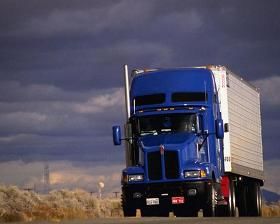How Do I Best Use The Automatic On Hills In Winter Conditions?
Topic 30999 | Page 1
I would say yes. Just start down the hills really slow, using the Jake as needed, but not in snow or slush.
You can try using the cruise control, set about five mph less than your desired speed because it will creep up. It all depends how steep the grade going down, and the weight in the box.
I apply the brakes whenever it starts climbing in speed, bring it down to five mph under my desired speed, then let off the brakes. Try to keep the RPMs under two grand. If you're moving up or down the hills below 45 mph put those flashers on, unless all the traffic is creeping (like construction zones or rush hour).
HOS:
Hours Of Service
HOS refers to the logbook hours of service regulations.One other thing is if you're not sure if you did use too much braking coming down a grade. In a safe place, pull off afterwards and have a look, smell, and feel of your brakes at each position-truck AND trailer.
If these are getting cooked, you will see smoke coming off them; smell the noxious fumes of hot brakes; feel the heat coming off them with the back of your hand.
You're going to smell the brakes of a hot rod driver zipping down the mountain too fast from miles away.
I get the theory of stab braking, so I'm guessing snow/ice/slush is just the same thing, only much slower? I thought cruise and Jake were no-no with any moisture on the roadway.
I would say yes. Just start down the hills really slow, using the Jake as needed, but not in snow or slush.
You can try using the cruise control, set about five mph less than your desired speed because it will creep up. It all depends how steep the grade going down, and the weight in the box.
I apply the brakes whenever it starts climbing in speed, bring it down to five mph under my desired speed, then let off the brakes. Try to keep the RPMs under two grand. If you're moving up or down the hills below 45 mph put those flashers on, unless all the traffic is creeping (like construction zones or rush hour).
HOS:
Hours Of Service
HOS refers to the logbook hours of service regulations.Cruise and Jakes are definitely a No-No in slush, snow, or rain. Packrat mentioned to use them "but not in snow or slush."
The way he described is the way you go about it. Determine your safe speed, which is whatever speed you feel comfortable going down that hill. Brake until you are 5 mph below that safe speed, then release the brakes. Allow yourself to roll back up to that safe speed before braking to 5 mph below it again. Rinse repeat until you reach the bottom of the hill.
By the way, that's called "controlled braking", not stab braking. The stab method is only used in emergencies.

Turtle,
Isn't stab braking only useful when you don't have antilock brakes?
Turtle,
Isn't stab braking only useful when you don't have antilock brakes?
Technically, yes. ABS systems have largely taken away the need for the stab method. However, it is still a method to be used in the event of an emergency, such as when/if the ABS fails or when/if you go into a skid.
ABS has been mandated for about 40 years now.
What is the difference between controlled braking and stab braking?
What is the difference between controlled braking and stab braking?
That’s a good question. I thought stab breaking was when you determined a certain speed, say 40mph as an example. When you reach 40, you apply the service breaks until you slow down to 35. Then release the break until you hit 40 again. As Turtle put it, rinse and repeat. Is “controlled breaking” different? Just looking for a little more clarity on this question.
New Reply:
New! Check out our help videos for a better understanding of our forum features

















Preview:
This topic has the following tags:
Advice For New Truck Drivers Dealing With The Weather First Solo Months On The Road Safe Driving Tips Tips For Braking







 TT On Facebook
TT On Facebook
Ok, I am a smidge concerned about slippery driving conditions in a semi, with an automatic. Obviously I figured out the hill decent feature for summer time driving conditions. How do I safely "slow my roll" going downhill without roasting my brakes?
I grew up in Montana and learned snow/ice driving along the way. How do I transition that knowledge into the truck?